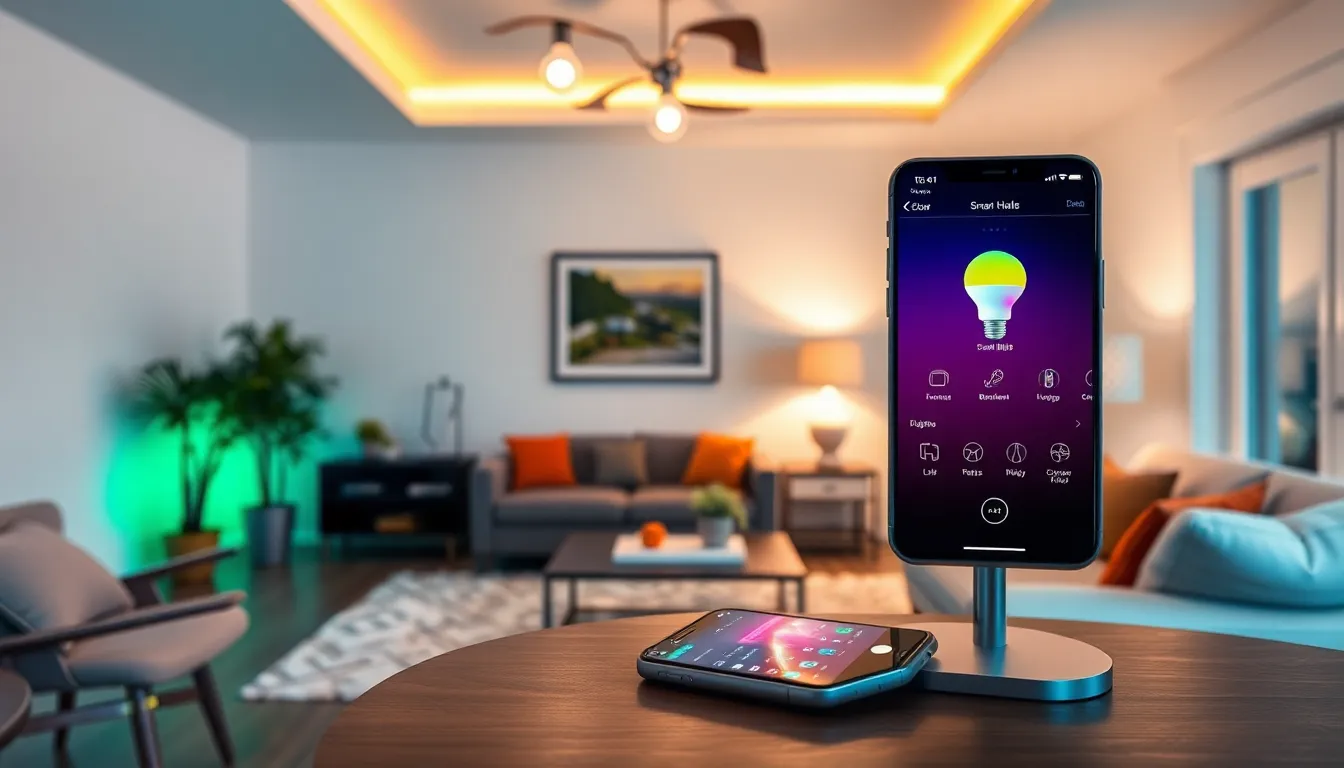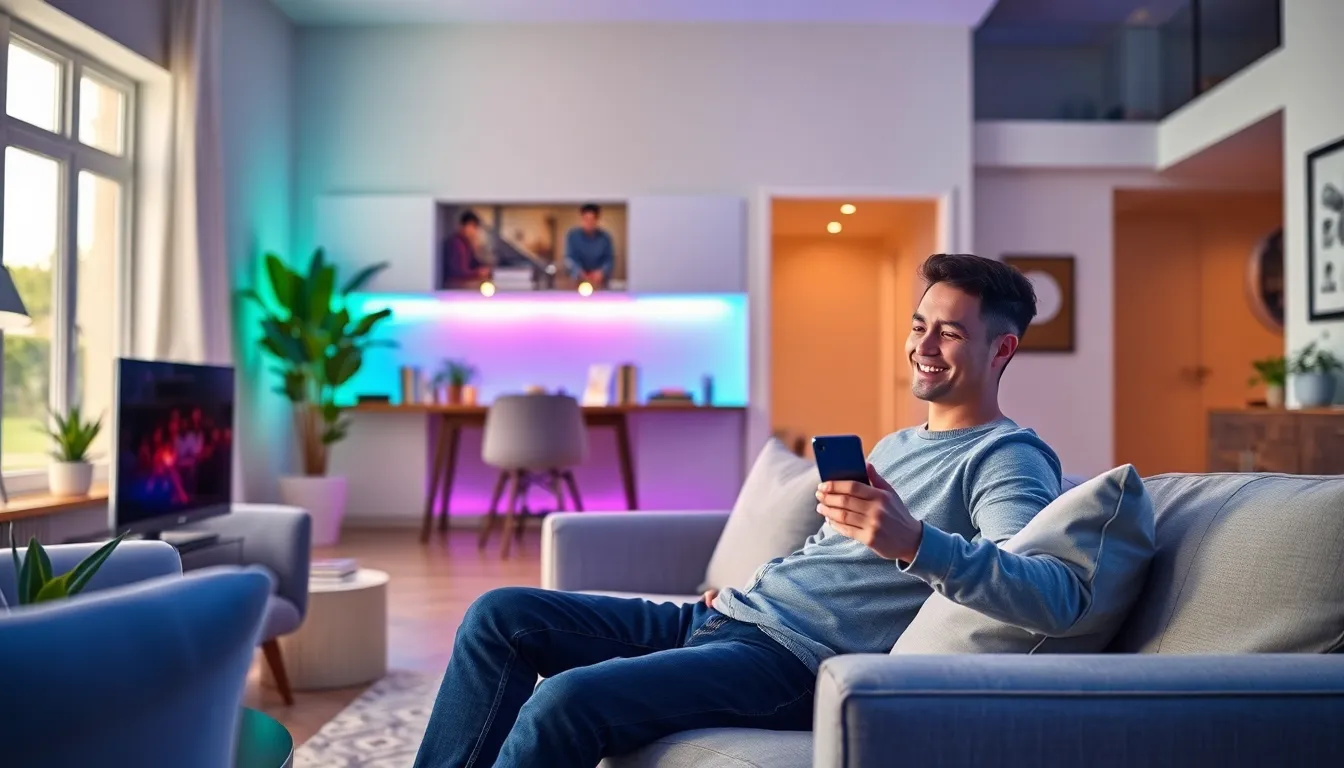Imagine walking into a room and having the lights greet you like an old friend. Smart lighting isn’t just about flipping a switch; it’s about creating an experience that’s as bright as your future. With a flick of your finger or a simple voice command, you can set the mood for movie night, dinner parties, or even those late-night snack raids.
Table of Contents
ToggleWhat Is Smart Lighting?
Smart lighting refers to advanced lighting systems that provide flexibility, convenience, and control. Such systems improve the user experience by integrating with various smart home technologies.
Definition and Overview
Smart lighting encompasses fixtures that can be controlled remotely via mobile apps, voice assistants, or smart home systems. These systems often include features like dimming, color changing, and scheduling. Users can create tailored lighting environments for diverse activities, enhancing the ambiance in homes or businesses. Integration with platforms like Amazon Alexa or Google Assistant allows for seamless voice control. Moreover, many smart lighting products prioritize energy efficiency, reducing overall electricity consumption.
How It Works
Smart lighting operates through wireless communication technologies, often using Wi-Fi, Zigbee, or Bluetooth. Each light fixture connects to a central hub or directly to the user’s smartphone. Users can access numerous settings, adjusting brightness and color temperature according to their needs. Scheduling features enable automatic on/off times, adding convenience. Some systems employ motion sensors to activate lighting in response to movement, further improving energy efficiency. These functionalities come together to create an adaptable lighting solution that fits modern lifestyles.
Benefits of Smart Lighting

Smart lighting systems offer numerous benefits, making them a valuable addition to any home or business. Key advantages include energy efficiency, enhanced control, and convenience.
Energy Efficiency
Energy efficiency stands out as a primary benefit of smart lighting. Users can program lights to turn off when no one is present, reducing unnecessary energy consumption. Smart bulbs often use LED technology, which uses up to 80% less energy than traditional incandescent bulbs. Moreover, scheduling capabilities allow for automatic adjustments based on personal routines or seasonal changes. Utilizing dimming options can also significantly lower energy use, contributing to reduced overall electricity bills. Implementing smart lighting creates energy savings while promoting eco-friendly practices.
Enhanced Control and Convenience
Enhanced control and convenience characterize smart lighting systems. Users can manage their lights remotely through mobile apps, eliminating the need to be physically present. Voice command features allow for hands-free control through popular smart home assistants, increasing accessibility. Customization options enable users to create specific lighting scenes, adjusting brightness and color temperature for various occasions. Furthermore, integration with other smart home devices enhances the overall experience; for instance, lights can automatically turn on when a user enters a room, providing seamless operation. Such convenience improves daily life, making smart lighting a practical solution for modern living.
Popular Smart Lighting Options
Smart lighting options enhance convenience and customization for users. Various products cater to specific needs, making it simple to upgrade any space.
Smart Bulbs
Smart bulbs provide an efficient option for transforming traditional fixtures. These bulbs come with advanced features like color changing, dimming, and scheduling. They can connect directly to Wi-Fi or through hubs, allowing users to adjust settings via mobile apps or voice commands. According to industry reports, LED smart bulbs use up to 80% less energy than incandescent alternatives. Users can create specific lighting scenes, perfect for movie nights or vibrant gatherings. Compatibility with various smart home systems offers seamless integration into existing setups.
Smart Switches
Smart switches give users another level of control over their lighting systems. Instead of replacing individual bulbs, these devices allow conventional lights to become part of a smart setup. Users can control multiple fixtures at once, simplifying operations with a single touch or voice command. Smart switches typically feature scheduling capabilities, ensuring lights operate efficiently throughout the day. Statistics reveal that significant energy savings occur when lights are automated, especially during low-traffic hours. This option also enhances home security, allowing users to simulate occupancy when away, deterring potential intruders.
Integration with Smart Home Systems
Smart lighting systems seamlessly integrate with various smart home systems for enhanced functionality. This integration allows users to control lighting alongside other devices, creating a cohesive smart home experience.
Compatibility with Assistants
Voice assistants such as Amazon Alexa, Google Assistant, and Apple Siri work effectively with smart lighting systems. Users can issue voice commands to adjust brightness, change colors, or set schedules. This direct compatibility streamlines the user experience by enabling interactive control without a physical interface. Additionally, the integration enhances the accessibility of smart lighting for all users.
Other Smart Devices
Smart lighting systems connect easily with other smart devices, contributing to a comprehensive home automation setup. For example, users can synchronize lights with smart thermostats, which adjust home temperatures based on occupancy. Security systems also benefit from this integration, turning on lights when motion sensors detect movement. Furthermore, connecting smart blinds can improve lighting dynamics throughout the day, enhancing comfort and energy efficiency.
Trends in Smart Lighting
Smart lighting technologies continue to evolve rapidly, enhancing user experience and convenience in everyday life. Key advancements shape the future of this sector.
Advances in Technology
LED technology serves as the backbone of smart lighting systems, delivering energy efficiency and longevity. Innovations in sensor technology enable motion detection, allowing lights to turn on automatically when someone enters a room. Additionally, cloud connectivity facilitates remote operation through mobile apps, enhancing user control. Integration of artificial intelligence allows systems to learn user habits, adjusting brightness and color based on preferences over time. Voice activation through smart assistants makes commands seamless, providing hands-free interaction. These advancements drive the popularity of smart lighting solutions, making them essential in modern households.
Future of Smart Lighting
Future trends in smart lighting align closely with sustainability and home automation. Predictive analytics and machine learning promise to enhance energy management, optimizing usage based on patterns. Integration with solar power sources provides eco-friendly options for homeowners. Expect an increase in customizable lighting experiences, allowing users to set personalized ambiances for different activities. Security features such as automated lighting setups will likely become standard to deter intruders. As smart cities develop, public spaces may incorporate interconnected smart lighting systems that adapt to real-time conditions. These developments illustrate a growing commitment to innovation in smart lighting, benefiting users and the environment.
Smart lighting represents a significant leap forward in how individuals interact with their environments. By merging convenience with energy efficiency it transforms everyday living spaces into dynamic settings tailored to personal preferences. The ability to control lighting through mobile apps and voice commands adds a layer of ease that modern users appreciate.
As technology continues to evolve smart lighting systems are expected to become even more integrated with other home automation tools. This evolution not only enhances user experience but also promotes sustainable living through energy-saving features. Embracing smart lighting is not just about illumination; it’s about creating a more connected and efficient lifestyle.


